Merchant navy ships are commercial vessels that are used for transporting goods, passengers, and sometimes military personnel. They are owned and operated by private companies and are engaged in international trade.
Commercial ships are various kinds of ships that transport cargo and passengers to different destinations. Commercial ships come in a range of sizes and shapes, to enable them to complete their intended purpose or duty. From freight liner ships to oil tankers, these ships are all designed to serve different purposes.
- Everything you need to know about Merchant Navy ships
- Types of Merchant Navy Ships
- Crew onboard Merchant Navy Ships
- Cargo onboard Merchant Navy Ships
- Where Merchant Ships Travel? Routes
- Merchant Navy Ships are registered to Different Flags
- Safety onboard Merchant navy Ships
- Training & Employment – Merchant Navy Ships
Everything you need to know about Merchant Navy ships

Do not confuse Merchant NAVY Ships with normal Naval Ships. Merchant navy ships and navy ships are different in terms of their primary purpose, ownership, crew composition, and operational responsibilities.
Merchant navy ships are primarily used for commercial purposes, such as transporting cargo and passengers, while navy ships are primarily used for military purposes, such as defense, surveillance, and combat operations.
Merchant navy ships are owned and operated by private companies, while navy ships are owned and operated by national governments.
The crew composition on merchant navy ships is usually comprised of civilians, including seafarers, officers, and other personnel. In contrast, the crew on navy ships is primarily composed of military personnel, including sailors, officers, and other specialized personnel.
Merchant navy ships operate in accordance with commercial contracts and schedules, while navy ships operate under the authority of national governments and are responsible for a variety of military missions, including combat operations, patrols, and humanitarian missions.
Merchant navy ships are subject to international maritime regulations, such as the International Convention for the Safety of Life at Sea (SOLAS) and the International Maritime Organization (IMO), which are designed to ensure the safety and security of the vessel, crew, and cargo. Navy ships, on the other hand, are subject to military regulations and are primarily focused on national security interests.
Types of Merchant Navy Ships

Types of merchant navy ships: There are various types of merchant navy ships, including container ships, bulk carriers, tankers, passenger ships, ferries, and specialized ships like ro-ro vessels and heavy-lift ships.
We have attempted to describe a few forms of merchant vessels, to thoroughly address and answer the question- “What are the different types of ships?” However, these are not limited to them.
Merchant navy ships come in various types, each designed for a specific purpose. These ships are used for transporting goods, passengers, and sometimes military personnel. In this article, we’ll discuss the different types of merchant navy ships and their functions.
1. Container ships
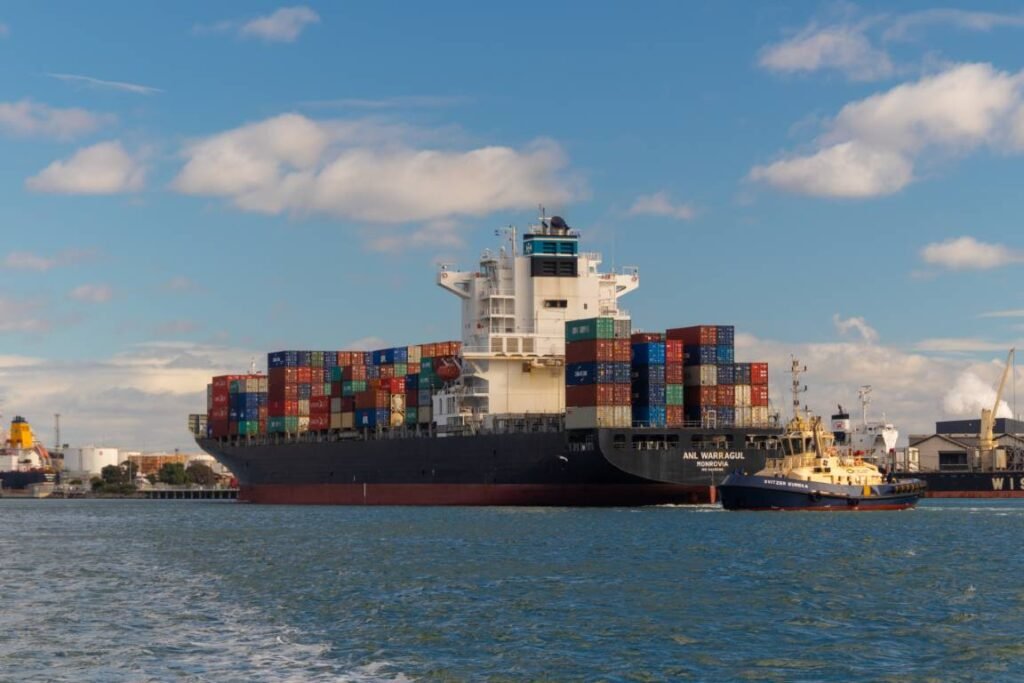
Container ships are the most common type of merchant navy ships. They are designed to transport cargo in standard-sized containers, which are loaded and unloaded using cranes.
These ships can carry a large volume of cargo, and their sizes range from small feeder ships to mega container ships that can carry up to 22,000 containers. The cargo carried by these ships includes consumer goods, raw materials, and industrial products.
Also Read Top 10 Biggest Container Shipping Companies in World (2023)
2. Bulk carriers

Bulk carriers are used for transporting bulk cargo such as coal, iron ore, and grain. These ships are designed to carry cargo in large quantities, without packaging, and they use a system of conveyor belts to load and unload the cargo.
Bulk carriers can be categorized into various types such as handy size, panamax, and capesize, depending on their size and carrying capacity.
3. Tankers

Tankers are designed for transporting liquids such as crude oil, petroleum products, and chemicals. These ships have large tanks, and the cargo is loaded and unloaded through pipes. Tankers can be categorized into various types such as product tankers, crude oil tankers, and chemical tankers, depending on the type of liquid they transport.
There are many other types of Tankers,
- Crude Oil Tankers: These ships are designed to transport unrefined crude oil from production sites to refineries around the world. They range in size from small, coastal vessels to massive supertankers capable of carrying over 2 million barrels of oil.
- Product Tankers: These ships are designed to transport refined petroleum products, including gasoline, diesel fuel, jet fuel, and other fuels. They are typically smaller than crude oil tankers and are used to transport refined products to markets around the world.
- Chemical Tankers: These ships are designed to transport a variety of chemicals, including acids, fertilizers, and other hazardous substances. They are built with specialized tanks and equipment to ensure safe handling and transport of these materials.
- LNG Carriers: These ships are designed to transport liquefied natural gas (LNG) from production sites to terminals around the world. They are built with specialized tanks and insulation systems to keep the gas at extremely low temperatures during transport.
- LPG Carriers: These ships are designed to transport liquefied petroleum gas (LPG), including propane and butane, from production sites to markets around the world. They are built with specialized tanks and equipment to ensure safe handling and transport of these highly flammable materials.
- Bitumen Tankers: These ships are designed to transport bitumen, a heavy, viscous substance used in road construction and other industrial applications. They are built with specialized tanks and heating systems to ensure that the bitumen remains in a liquid state during transport.
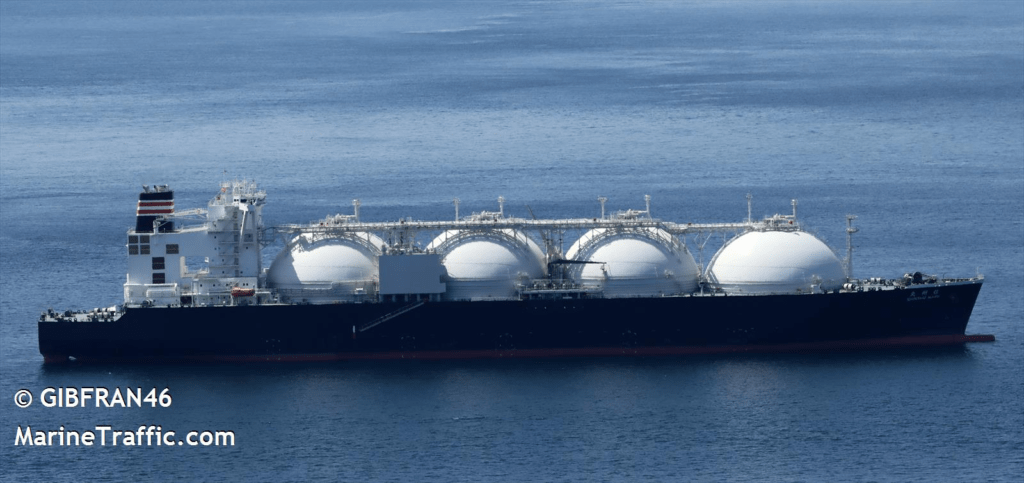
Also Read 10 Facts about Knock Nevis – Seawise Giant, the Biggest Supertanker ever made
4. Ro-ro vessels
Ro-ro (roll-on/roll-off) vessels are designed to transport vehicles, heavy machinery, and other equipment that can be driven on and off the ship. These ships have large ramps at the front and back, which allow vehicles to be loaded and unloaded. Ro-ro vessels can also carry containers and other types of cargo.
Also Read Everything about Car Carrier Ships Explained – Types, Cargo Operations & History
5. Passenger ships
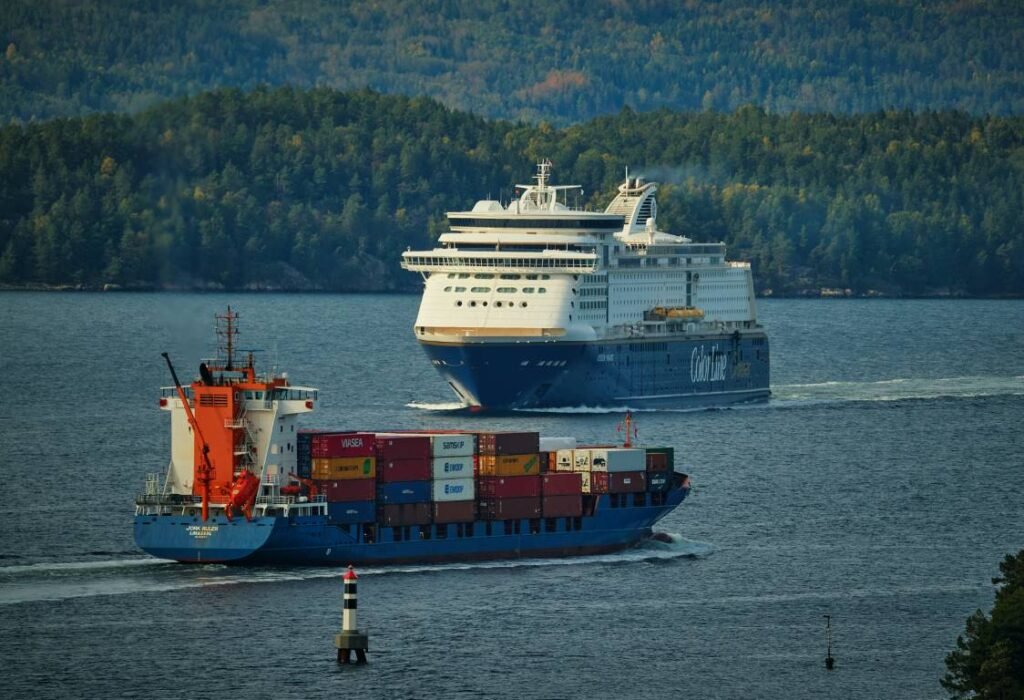
Passenger ships are designed for transporting people. These ships can range from small ferries to large cruise ships. Passenger ships are equipped with various amenities such as restaurants, bars, swimming pools, and entertainment facilities. These ships also have cabins for overnight stays.
6. Ferries

Ferries are used for transporting passengers and vehicles across water bodies such as rivers and seas. These ships can carry a large number of passengers and vehicles, and they operate on established routes. Ferries are equipped with facilities such as restaurants, shops, and seating areas.
7. Heavy-lift ships
Heavy-lift ships are designed for transporting oversized and heavy cargo such as construction equipment, wind turbines, and large machinery. These ships have large cranes that can lift and transport cargo weighing up to several hundred tons.
Types of merchant navy ships are varied, and each has its unique features and functions. Container ships, bulk carriers, tankers, ro-ro vessels, passenger ships, ferries, and heavy-lift ships are all essential in the global trade industry.
These ships play a vital role in transporting goods and people across the world’s seas and oceans, connecting various countries and driving economic growth.
Crew onboard Merchant Navy Ships
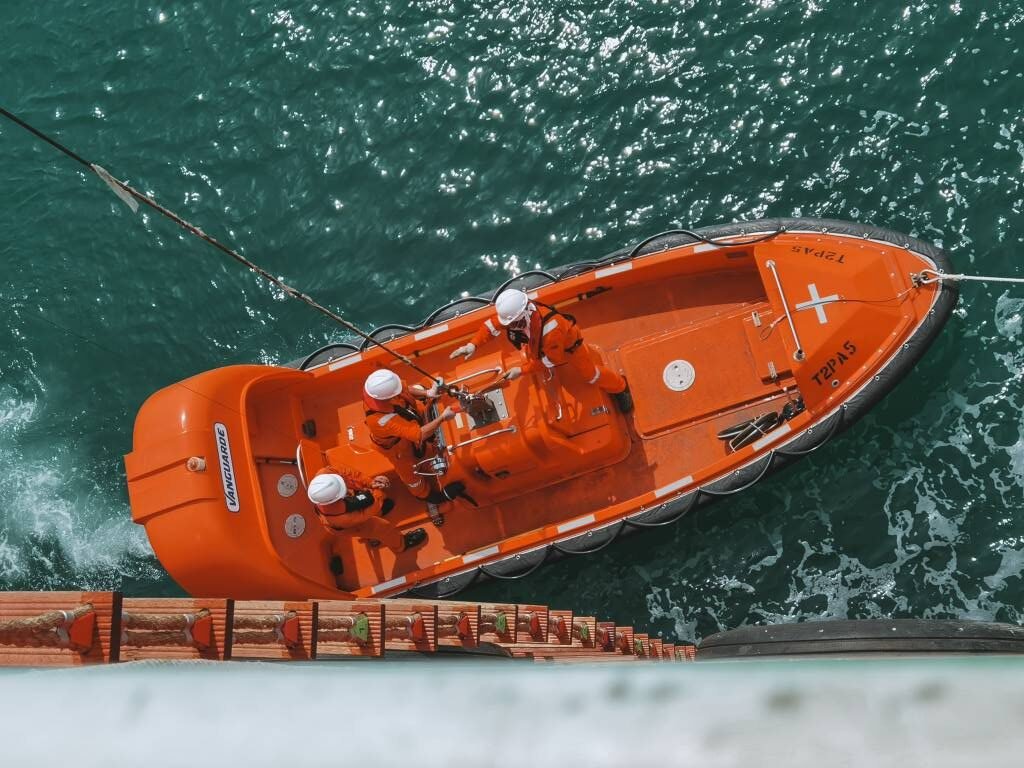
Crew: Merchant navy ships require a crew that comprises officers and ratings. The officers are responsible for navigating the ship, managing the cargo, and ensuring the safety of the crew and the vessel. Ratings perform various duties such as maintaining the ship’s equipment, handling cargo, and assisting the officers.
Merchant navy ships are commercial vessels that are used for transporting goods, passengers, and sometimes military personnel. To operate these ships, they require a crew comprising officers and ratings. In this article, we will discuss the roles of the crew members onboard merchant navy ships.
- Officers The officers onboard a merchant navy ship are responsible for managing the vessel, navigating it, and ensuring the safety of the crew and cargo. The captain is the overall in-charge of the ship and is responsible for its safe operation. The captain is also responsible for managing the crew and ensuring that they perform their duties effectively.
- Ratings The ratings onboard a merchant navy ship perform various duties, including operating and maintaining the ship’s equipment, handling cargo, and assisting the officers. Ratings are essential members of the crew and are responsible for ensuring that the ship runs smoothly.
- The Able Seaman (AB) is responsible for the general maintenance and cleanliness of the ship. The AB also assists the deck officers with navigation and cargo operations.
- The Engine Rating is responsible for the maintenance and operation of the ship’s engines, machinery, and other systems. The Engine Rating ensures that the ship’s engines are functioning correctly and that the ship is maintained in good condition.
- The Cook is responsible for preparing meals for the crew and officers. The cook ensures that the meals are nutritious and that they are prepared in a clean and hygienic environment.
Also Read, related Blog Posts on
- For those who chose the sea
- 10 Reasons to Work in the Marine Industry
- 10+ New Job Opportunities in Marine Industry – 2023
Cargo onboard Merchant Navy Ships
Cargo: Merchant navy ships transport a wide range of cargo, including food, raw materials, consumer goods, and industrial products. Tankers are used for transporting oil and other liquids, while container ships carry a variety of goods in containers.
Merchant navy ships are designed and built to transport various types of cargo across the world’s seas and oceans. The cargo that is transported can be in the form of dry bulk, liquid bulk, containerized, or specialized cargo. In this article, we will discuss the different types of cargo that can be carried onboard a merchant navy ship.
- Dry Bulk Cargo Dry bulk cargo refers to the shipment of goods that are not liquid or gas in nature. Examples of dry bulk cargo include grains, coal, iron ore, and other minerals. Dry bulk cargo is transported in bulk carriers, which are large vessels that can carry huge quantities of cargo. Bulk carriers have large holds that are specially designed to carry dry bulk cargo. The cargo is loaded and unloaded using cranes and conveyor belts.
- Liquid Bulk Cargo Liquid bulk cargo refers to the shipment of goods that are in a liquid or gas form. Examples of liquid bulk cargo include crude oil, petroleum products, chemicals, and liquefied gases. Liquid bulk cargo is transported in tankers, which are specially designed vessels that can carry large quantities of liquid cargo. Tankers have large storage tanks that are designed to hold the cargo safely. The cargo is loaded and unloaded using pumps and pipelines.
- Containerized Cargo Containerized cargo refers to the shipment of goods that are packed in standard containers. Containers are large, rectangular boxes that are designed to be transported on trucks, trains, and ships. Containerized cargo is transported in container ships, which are specially designed vessels that can carry a large number of containers. Containers are loaded and unloaded using cranes and specialized container handling equipment.
- Specialized Cargo Specialized cargo refers to the shipment of goods that require special handling or transport. Examples of specialized cargo include automobiles, heavy machinery, and livestock. Specialized cargo is transported in specialized vessels that are designed to carry the cargo safely. Automobiles and heavy machinery are transported on roll-on/roll-off vessels, while livestock is transported in livestock carriers.
Related Topics,
- Top 10 Biggest Container Shipping Companies in World (2023)
- 10+ New Job Opportunities in Marine Industry – 2023
- Top 10 Biggest LNG Ships of 2023
Where Merchant Ships Travel? Routes

Routes: Merchant navy ships sail on established trade routes that connect major ports around the world. The routes are determined by factors such as cargo demand, distance, and shipping lanes.
Merchant ships are vessels designed and built to transport cargo across the world’s seas and oceans. These ships travel on established shipping routes, connecting different regions of the world and facilitating international trade. In this article, we will discuss where merchant ships travel and the different shipping routes they take.
- Asia-Europe Route The Asia-Europe route is one of the busiest and most important shipping routes in the world, connecting ports in Asia with ports in Europe. The route starts from ports in China, Japan, and South Korea and ends in ports in Northern Europe, such as Rotterdam, Hamburg, and Antwerp. The route is used to transport various types of cargo, including consumer goods, machinery, and raw materials.
- Transpacific Route The transpacific route connects ports in Asia with ports on the west coast of North America, such as Los Angeles and Vancouver. The route is used to transport goods such as electronics, clothing, and machinery. The route is also used to transport crude oil from the Middle East to Asia.
- Transatlantic Route The transatlantic route connects ports in Western Europe, such as Rotterdam and Hamburg, with ports on the east coast of North America, such as New York and Boston. The route is used to transport various types of cargo, including automobiles, machinery, and consumer goods.
- Indian Ocean Route The Indian Ocean route connects ports in the Middle East and Asia with ports in Africa and Europe. The route is used to transport various types of cargo, including oil and gas, consumer goods, and machinery.
- South American Route The South American route connects ports in South America with ports in North America, Europe, and Asia. The route is used to transport various types of cargo, including agricultural products, minerals, and oil and gas.
- Intra-Asian Route The Intra-Asian route connects ports within Asia, including ports in China, Japan, and South Korea. The route is used to transport various types of cargo, including consumer goods, machinery, and raw materials.
Also Read, Major Shipping Sea Routes of Global Trade
Merchant Navy Ships are registered to Different Flags
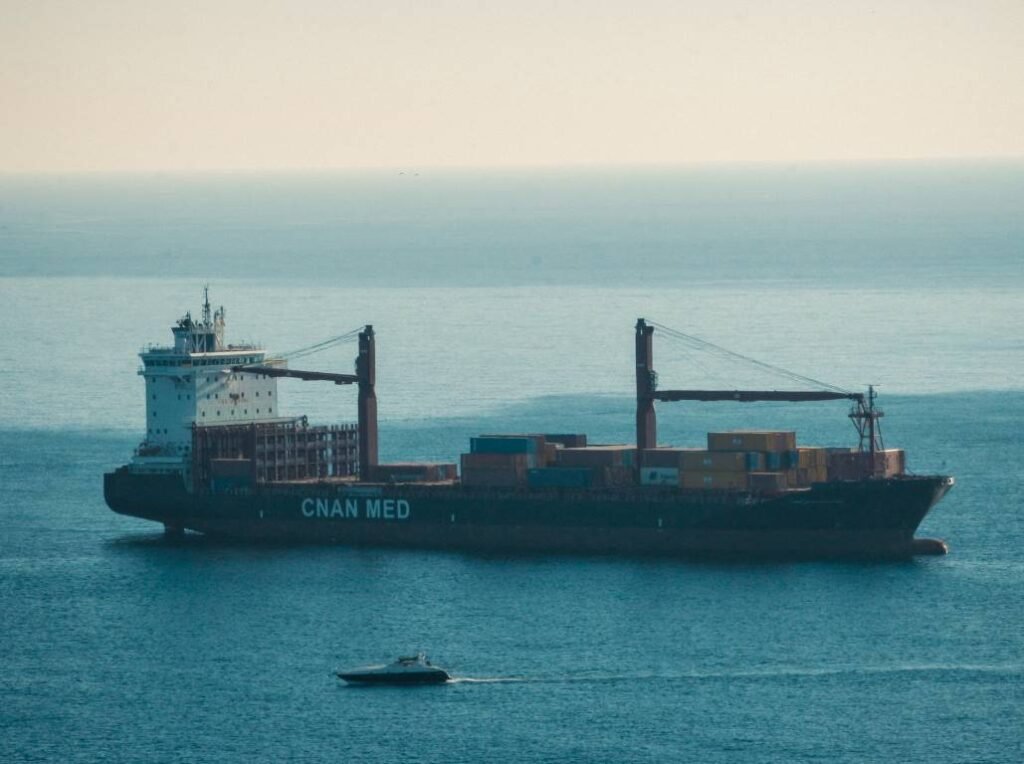
Flag: Merchant navy ships are registered under a flag of convenience, which means that they are registered in a country different from the owner’s country. The choice of flag is often based on tax benefits, lower registration fees, and less stringent regulations.
Merchant navy ships are registered to different flags, which is known as flag state. The flag state of a ship is the country under whose laws the ship is registered and which regulates the ship’s operations. The flag state has the authority to enforce laws and regulations relating to the safety, security, and environmental standards of the ship.
Ships can be registered to any country that offers registration services, regardless of the ship’s country of ownership or the nationality of the crew. The registration process is commonly referred to as flagging, and a ship is said to be “flagged” to a particular country.
The flag state of a ship plays an important role in ensuring the safety and security of the vessel, crew, and cargo. It also determines the regulatory framework under which the ship operates. For example, the flag state may require a certain level of safety equipment on board the ship or may require a particular standard of training for the crew.
The choice of flag state is often influenced by a variety of factors, including the regulatory framework of the country, the quality of the flag state’s port and coastal infrastructure, and the cost of registration and ongoing maintenance.
Some countries are popular flag states for merchant navy ships, including Panama, Liberia, the Marshall Islands, Malta, and Singapore. These countries offer a range of registration services and have established reputations for providing high levels of regulatory oversight and support.
You may also like, Reasons Why Ships are registered in Panama?
Safety onboard Merchant navy Ships
Safety: Merchant navy ships are subject to strict safety regulations to ensure the safety of the crew, cargo, and vessel. The International Maritime Organization (IMO) sets standards for the construction, equipment, and operation of merchant navy ships.
Safety is of utmost importance on merchant navy ships, and the shipping industry has implemented various measures to ensure the safety of the vessel, crew, and cargo. In this article, we will discuss some of the safety measures implemented onboard merchant navy ships.
All crew members on board merchant navy ships are required to undergo training and obtain certification in accordance with international standards. This training covers various aspects of safety, including fire prevention and fighting, personal safety, and survival techniques.
Merchant navy ships are equipped with sophisticated navigation and communication equipment that enables the crew to navigate safely and communicate with other vessels, port authorities, and emergency services.
International Safety Standards Merchant navy ships are required to comply with a range of international safety standards, including the International Convention for the Safety of Life at Sea (SOLAS), the International Safety Management (ISM) Code, and the International Ship and Port Facility Security (ISPS) Code. These standards are designed to ensure that ships are built and operated to the highest safety standards.
You may also like,
Training & Employment – Merchant Navy Ships
To work on a merchant navy ship, crew members must undergo rigorous training and obtain appropriate certifications. Training includes navigation, firefighting, first aid, and emergency procedures.
Working on a merchant navy ship can be a lucrative career, with opportunities for advancement and travel. However, the work is demanding and can involve long periods away from home. Jobs include captain, engineer, deck officer, and rating.
Merchant navy ships are an essential part of global trade, transporting goods and passengers around the world. They require a well-trained crew, strict safety standards, and operate on established trade routes.
Now, How to Join Merchant Navy?

